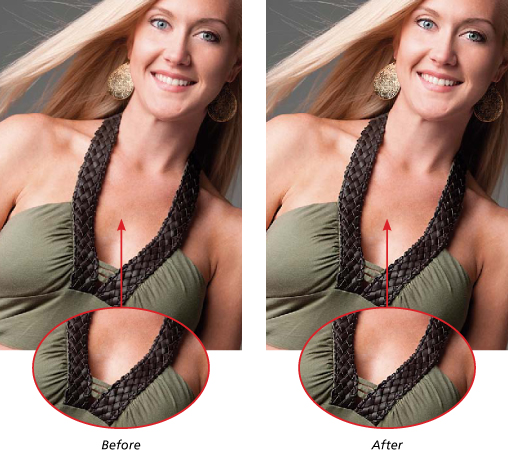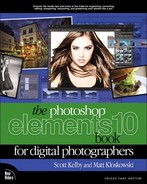Basic Sharpening
After you’ve color corrected your photos and right before you save your files, you’ll definitely want to sharpen them. I sharpen every digital camera photo I take, either to help bring back some of the original crispness that gets lost during the correction process, or to help fix a photo that’s slightly out of focus. Either way, I haven’t met a digital camera (or scanned) photo that didn’t need a little sharpening. Here’s a basic technique for sharpening the entire photo:
Step One:
Open the photo that you want to sharpen. Because Elements displays your photo in different ways at different magnifications, choosing the right magnification (also called the zoom amount) for sharpening is critical. Because today’s digital cameras produce such large-sized files, it’s now pretty much generally accepted that the proper magnification to view your photos during sharpening is 50%. If you look up in your image window’s title bar, or down in the bottom-left corner of the window, it displays the current percentage of zoom (shown circled here in red). The quickest way to get to a 50% magnification is to press Ctrl-+ (plus sign; Mac: Command-+) or Ctrl-– (minus sign; Mac: Command-–) to zoom the magnification in or out.

SCOTT KELBY
Step Two:
Once you’re viewing your photo at 50% size, go under the Enhance menu and choose Unsharp Mask. (If you’re familiar with traditional darkroom techniques, you probably recognize the term “unsharp mask” from when you would make a blurred copy of the original photo and an “unsharp” version to use as a mask to create a new photo whose edges appeared sharper.)
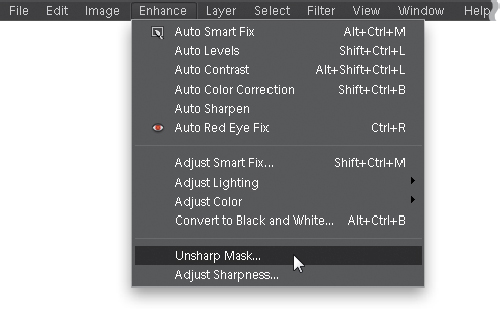
When the Unsharp Mask dialog appears, you’ll see three sliders. The Amount slider determines the amount of sharpening applied to the photo; the Radius slider determines how many pixels out from the edge that the sharpening will affect; and the Threshold slider determines how different a pixel must be from the surrounding area before it’s considered an edge pixel and sharpened by the filter. Threshold works the opposite of what you might think—the lower the number, the more intense the sharpening effect. So, what numbers do you enter? I’ll give you some great starting points on the following pages, but for now, we’ll just use these settings: Amount: 125%, Radius: 1, and Threshold: 3. Click OK and the sharpening is applied to the photo.
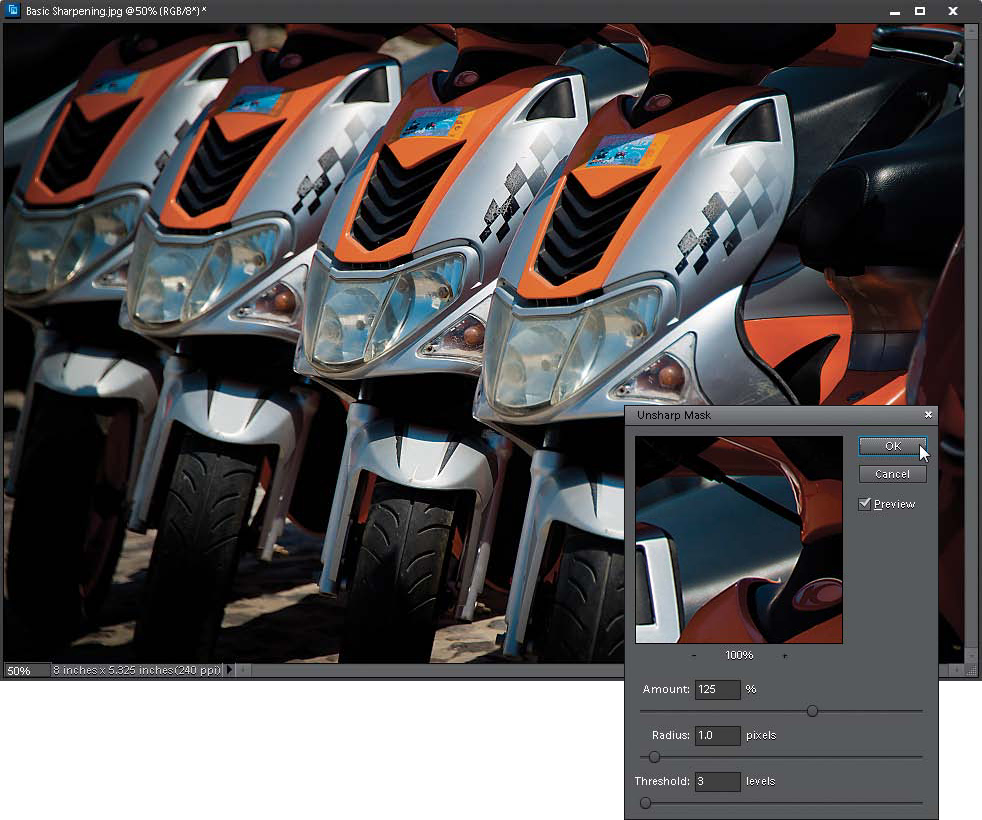
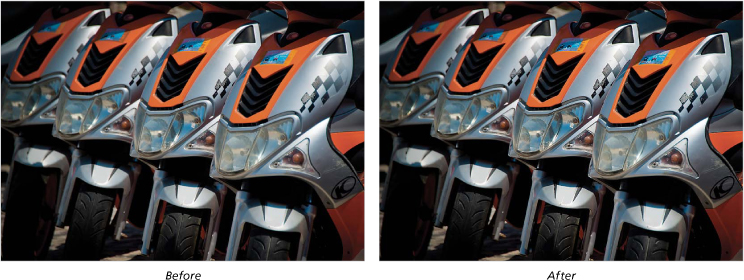
Here are the Unsharp Mask settings—Amount: 150%, Radius: 1, Threshold: 10—that work well for images where the subject is of a softer nature (e.g., flowers, puppies, people, rainbows, etc.). It’s a subtle application of sharpening that is very well suited to these types of subjects.
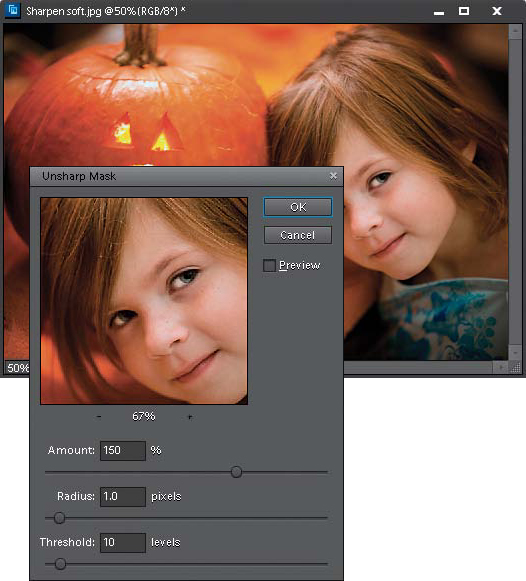
SCOTT KELBY
Sharpening Portraits:
If you’re sharpening a close-up portrait (head-and-shoulders type of thing), try these settings—Amount: 75%, Radius: 2, Threshold: 3—which applies another form of subtle sharpening.
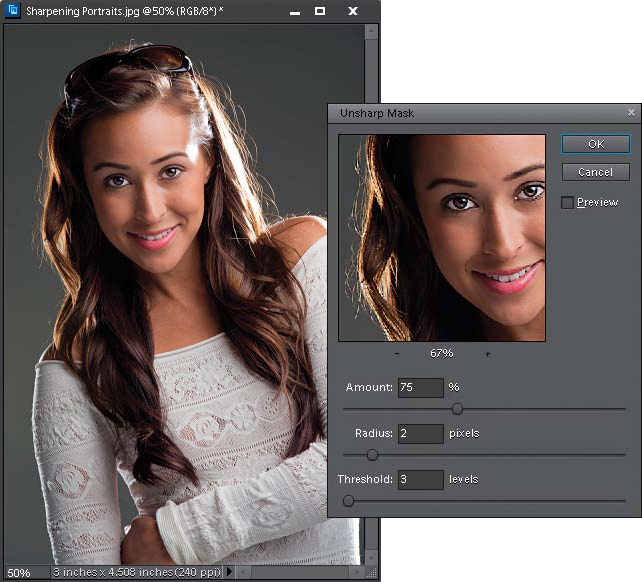
SCOTT KELBY
This is a moderate amount of sharpening that works nicely on product shots, photos of home interiors and exteriors, and landscapes. If you’re shooting along these lines, try applying these settings—Amount: 225%, Radius: 0.5, Threshold: 0—and see how you like it (my guess is you will).
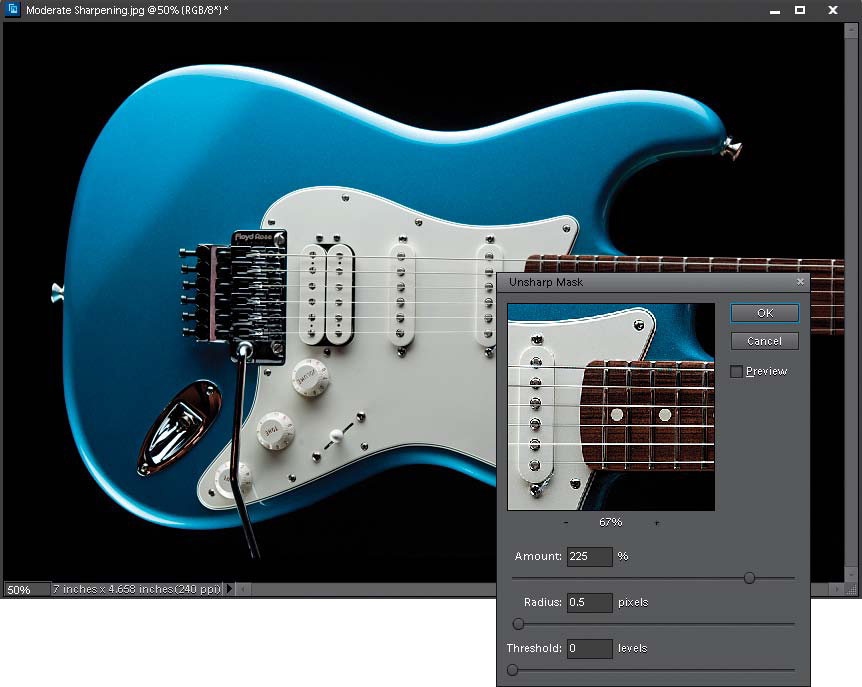
SCOTT KELBY
Maximum Sharpening:
I use these settings—Amount: 65%, Radius: 4, Threshold: 3—in only two situations: (1) The photo is visibly out of focus and it needs a heavy application of sharpening to try to bring it back into focus; or (2) the photo contains lots of well-defined edges (e.g., buildings, coins, cars, machinery, etc.).
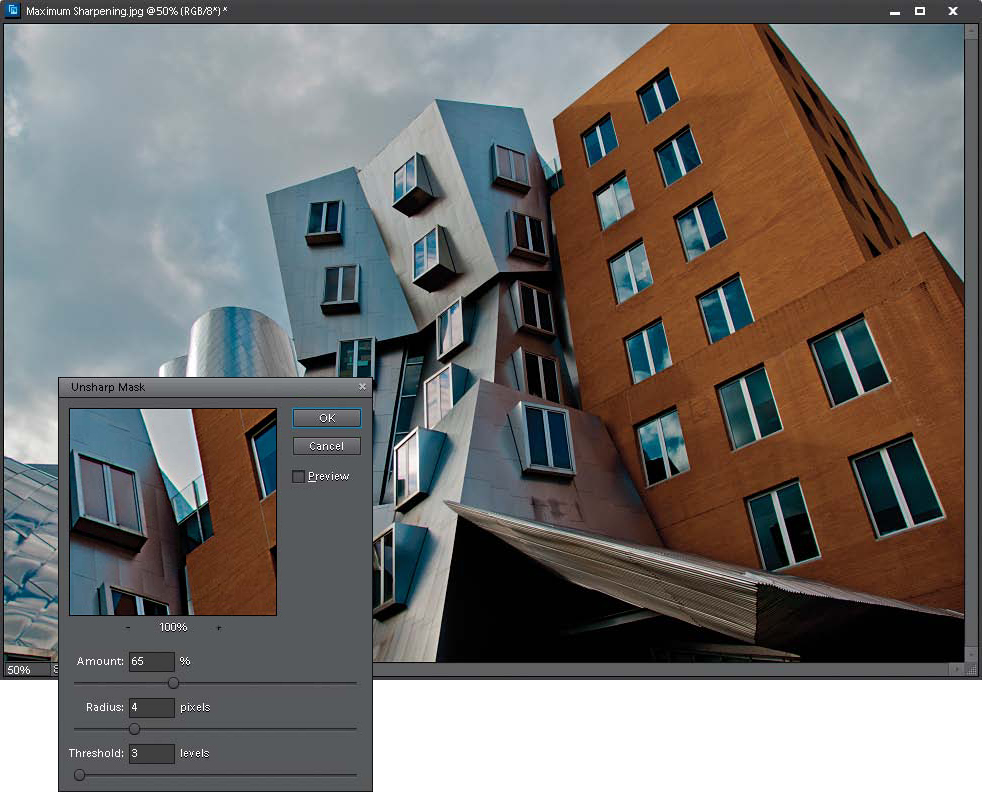
SCOTT KELBY
These are probably my all-around favorite sharpening settings—Amount: 85%, Radius: 1, Threshold: 4—and I use these most of the time. It’s not a “knock-you-over the-head” type of sharpening—maybe that’s why I like it. It’s subtle enough that you can apply it twice if your photo doesn’t seem sharp enough after the first application (just press Ctrl-F [Mac: Command-F]), but once will usually do the trick.
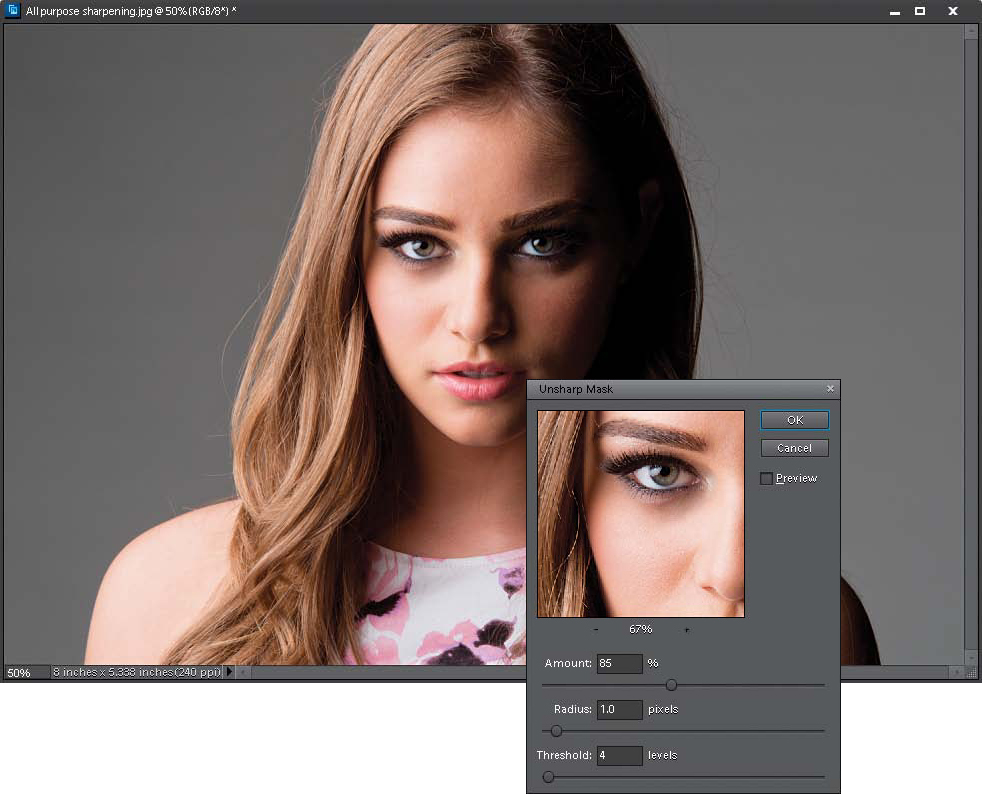
SCOTT KELBY
Web Sharpening:
I use these settings—Amount: 400%, Radius: 0.3, Threshold: 0—for Web graphics that look blurry. (When you drop the resolution from a highres, 300-ppi photo down to 72 ppi for the Web, the photo often gets a bit blurry and soft.) I also use this same sharpening on out-of-focus photos. It adds some noise, but I’ve seen it rescue photos that I would have otherwise thrown away. If the effect seems too intense, try dropping the Amount to 200%.

SCOTT KELBY
Coming Up with Your Own Settings:
If you want to experiment and come up with your own custom blend of sharpening settings, I’ll give you some typical ranges for each adjustment so you can find your own sharpening “sweet spot.”
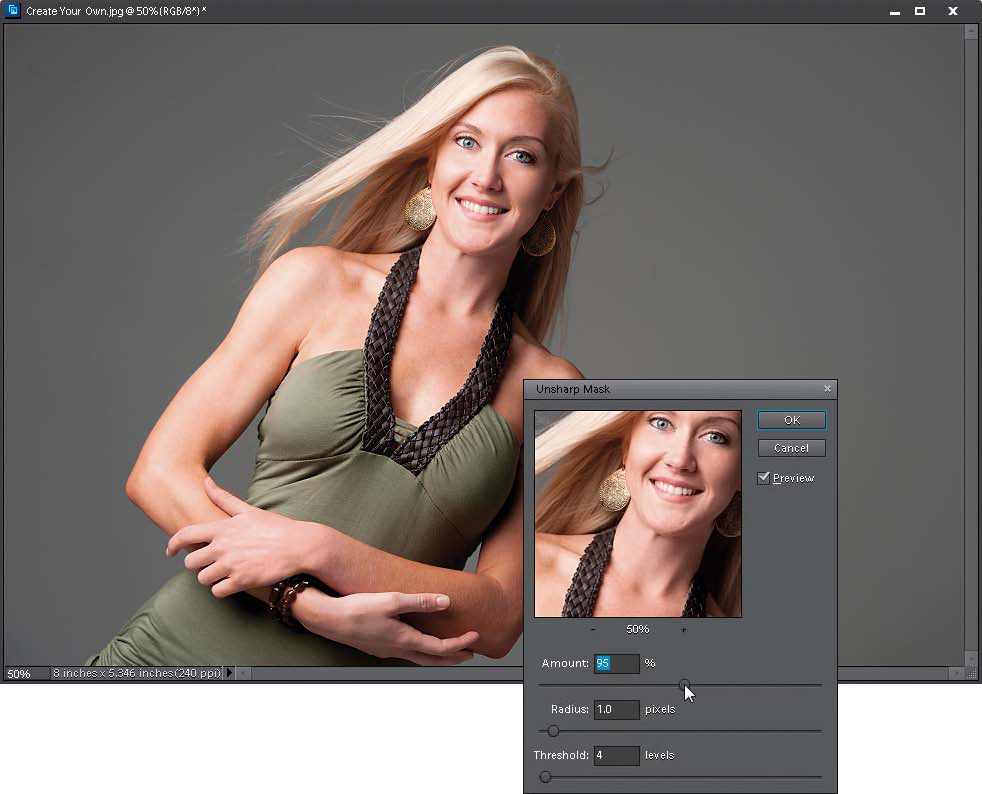
SCOTT KELBY
Amount
Typical ranges go anywhere from 50% to 150%. This isn’t a rule that can’t be broken. It’s just a typical range for adjusting the Amount, where going below 50% won’t have enough effect, and going above 150% might get you into sharpening trouble (depending on how you set the Radius and Threshold). You’re fairly safe to stay under 150%.
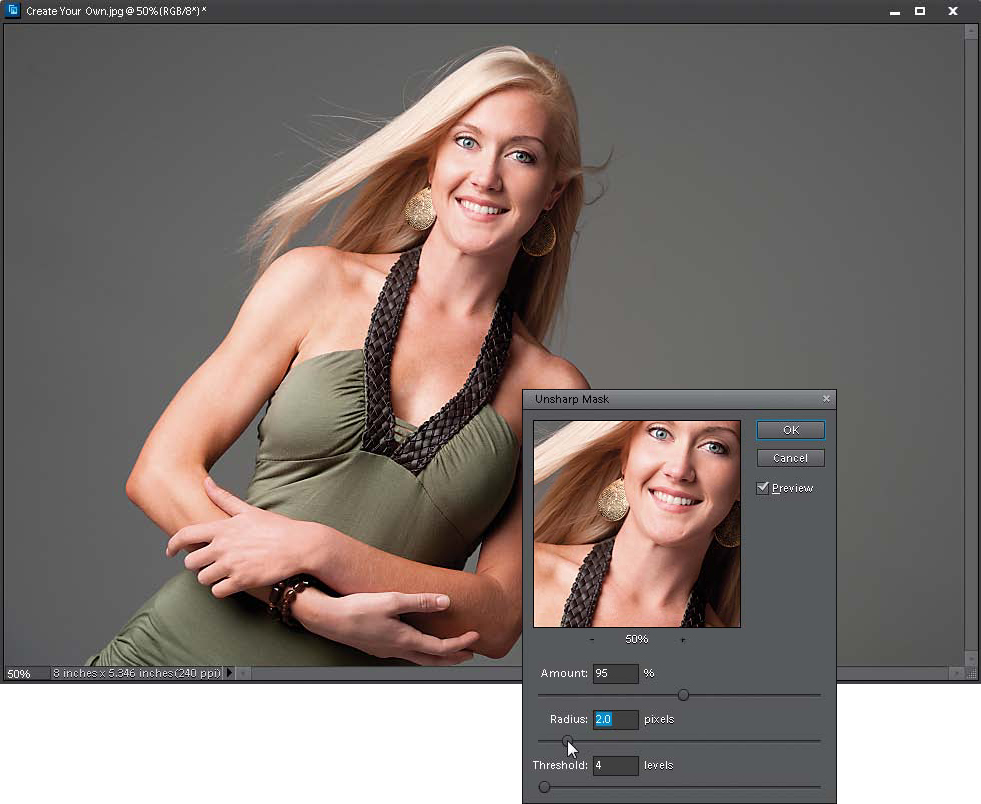
Radius
Most of the time, you’ll use just 1 pixel, but you can go as high as (get ready)—2. I gave you one setting earlier for extreme situations, where you can take the Radius as high as 4, but I wouldn’t recommend it very often. I once heard a tale of a man in Cincinnati who used 5, but I’m not sure I believe it.
A pretty safe range for the Threshold setting is anywhere from 3 to around 20 (3 being the most intense, 20 being much more subtle. I know, shouldn’t 3 be more subtle and 20 more intense? Don’t get me started). If you really need to increase the intensity of your sharpening, you can lower the Threshold to 0, but keep a good eye on what you’re doing (watch for noise appearing in your photo).
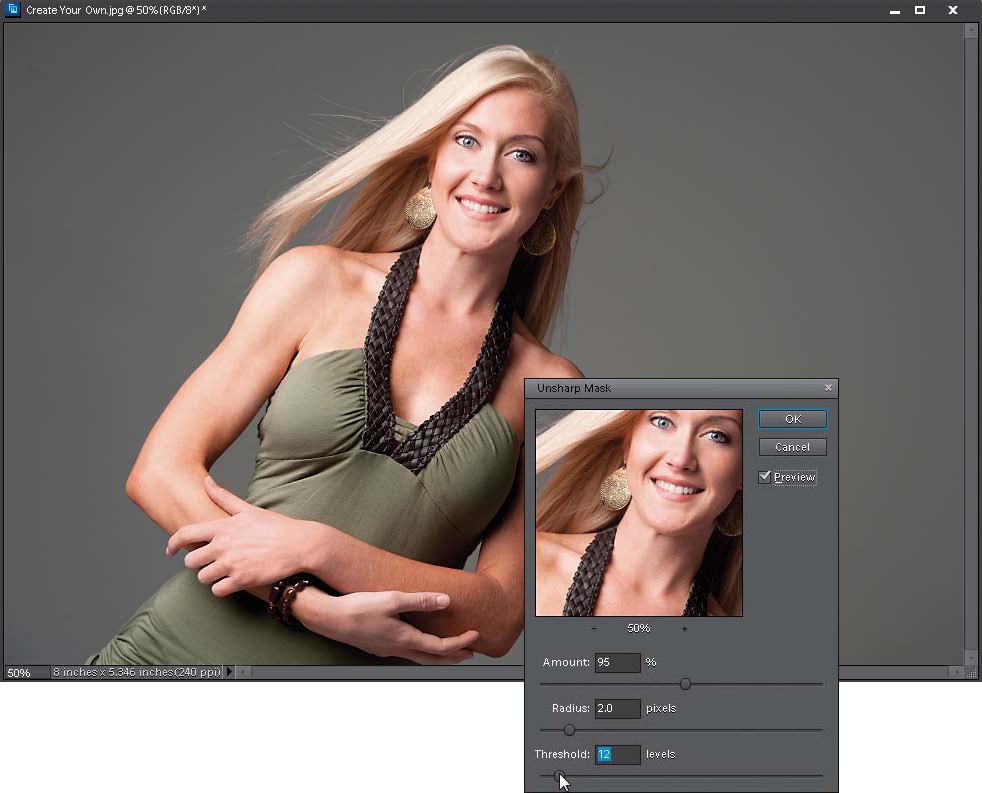
The Final Image
For the final sharpened image you see here, I used the Portrait sharpening settings I gave earlier, and then I dragged the Amount slider to the right (increasing the amount of sharpening), until it looked right to me (I wound up at around 95%), and I increased the Threshold to 12. If you’re uncomfortable with creating your own custom Unsharp Mask settings, then start with this: pick a starting point (one of the set of settings I gave on the previous pages), and then just move the Amount slider and nothing else (so, don’t touch the Radius and Threshold sliders). Try that for a while, and it won’t be long before you’ll find a situation where you ask yourself, “I wonder if lowering the Threshold would help?” and by then, you’ll be perfectly comfortable with it.
